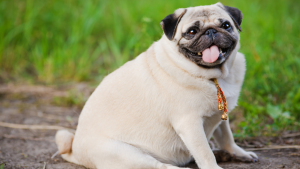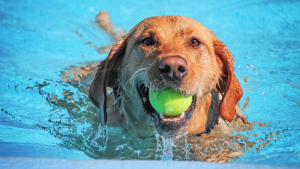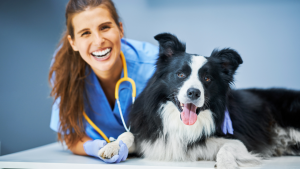Canine obesity is a significant issue affecting dogs today. It not only shortens their lives but also contributes to chronic pain and various health conditions. Fortunately, obesity in dogs is preventable and can be reversed through proper care and management.

The Prevalence of Canine Obesity
Obesity in dogs has become increasingly prevalent due to various factors in modern life. With changes in the role of dogs from working animals to companions, their activity levels have significantly decreased. Dogs are no longer engaged in activities like herding or hunting, which naturally keep them physically fit. Additionally, the limited exercise they receive in urban environments contributes to weight gain.
Another significant factor in the rising obesity rates among dogs is free-choice feeding and overconsumption of calories. Many pet owners provide unlimited access to food, allowing dogs to eat whenever they want. This practice can lead to overeating and excessive calorie intake, making weight management challenging.
To combat the prevalence of canine obesity, pet care, and dog owners must prioritize pet health and nutrition. By understanding and addressing the contributing factors, such as lack of exercise and excessive calorie intake, we can work towards preventing and managing obesity in our furry companions.
The Link Between Obesity and Pain in Dogs
Being overweight or obese can have detrimental effects on a dog’s health, including joint damage and the development of osteoarthritis. This can result in chronic pain, significantly impacting the dog’s quality of life. While it was previously believed that the pain and inflammation associated with obesity-related joint issues were primarily due to wear and tear, recent research has shed light on the role of fat tissue in exacerbating this pain.
Studies have shown that fat tissue secretes hormones and chemicals that contribute to inflammation in the body, including the joints. This inflammation worsens the pain experienced by overweight or obese dogs, making it even more crucial to address and manage their weight.
By understanding the link between obesity and pain in dogs, pet owners can take proactive steps to ensure their furry companions maintain a healthy weight and minimize the risk of chronic pain-related conditions. This includes maintaining a balanced diet, providing regular exercise, and consulting with veterinarians for tailored pet nutrition plans.
The Role of Nutrition in Managing Pain
Nutrition plays a key role in managing pain and inflammation in overweight or obese dogs. A well-balanced diet rich in essential nutrients can help support joint health and minimize inflammation. It is essential to choose pet food that is specifically formulated to meet the nutritional needs of overweight or obese dogs, promoting weight loss while maintaining optimal health.
Additionally, certain dietary supplements, such as omega-3 fatty acids, glucosamine, and chondroitin, may provide additional support for joint health and alleviate pain. Consulting with a veterinarian can help determine the most suitable dietary options and supplements for a dog’s specific needs.
Exercise and Weight Management
Regular exercise is vital for dogs in managing their weight and reducing the risk of pain-related issues. Exercise helps burn calories, build lean muscle mass, and improve overall joint health. However, it is essential to tailor exercise routines to a dog’s age, breed, and overall health condition to prevent further strain on the joints.
Low-impact activities like swimming, controlled walks, and interactive play sessions can be beneficial for overweight or obese dogs, as these activities provide exercise without placing excessive stress on the joints. Gradually increasing exercise duration and intensity, under the guidance of a veterinarian, can help dogs safely lose weight and improve their overall well-being.
Consulting with a Veterinarian
When addressing obesity and pain in dogs, it is crucial to work closely with a veterinarian. They can evaluate a dog’s overall health, determine the ideal weight, and develop a comprehensive weight loss plan. Veterinarians can guide nutrition, and exercise, and monitor progress throughout the weight management journey.
Regular check-ups with a veterinarian are essential for assessing pain levels, monitoring joint health, and adjusting the weight management strategy as needed. By partnering with a veterinarian, pet owners can ensure the best possible care for their dogs and alleviate the pain associated with obesity-related conditions.
| Benefits of Managing Obesity in Dogs | |
|---|---|
| 1 | Pain reduction and improved mobility |
| 2 | Reduced risk of obesity-related health conditions (diabetes, heart disease, etc.) |
| 3 | Enhanced overall quality of life |
| 4 | Improved energy levels and vitality |
Strategies for Preventing Canine Obesity
Preventing obesity in dogs requires a combination of mindful nutrition and regular exercise. By implementing the following strategies, pet owners can help ensure their dogs maintain a healthy weight and overall well-being.
Consult with a Veterinarian for Customized Nutritional Advice
A crucial step in preventing canine obesity is consulting with a veterinarian to choose the appropriate food for your dog’s specific nutritional needs. Petcare professionals can recommend a balanced diet that matches your dog’s age, breed, activity level, and any specific health considerations.
Practice Portion Control
Controlling portion sizes is essential to prevent overeating and weight gain in dogs. Dog owners should carefully measure their pet’s daily food intake based on the veterinarian’s recommendations. Avoid free-choice feeding, as it can lead to excessive caloric consumption.
Establish Specific Meal Times
Establishing consistent meal times for your dog helps regulate their eating habits and avoids unnecessary snacking or begging for food. Stick to a regular schedule and avoid feeding pets from the table, as human food can be high in fat and detrimental to their health.
Engage Dogs in Interactive Feeding
Using interactive feeding toys, such as food puzzles or treat-dispensing toys, can engage your dog mentally and physically during mealtime. These toys provide mental stimulation and encourage your dog to work for their food, slowing down their eating and preventing overconsumption.
Increase Exercise through Walks, Swimming, and Play
Regular exercise is crucial for canine weight management. Engage your dog in daily physical activities like walking, swimming, and playing fetch. Aim for at least 30 minutes to an hour of exercise, depending on your dog’s breed and energy level.
By implementing these pet care strategies, pet owners can take proactive steps to prevent obesity in their beloved dogs. Consultation with a veterinarian, portion control, establishing meal times, interactive feeding, and regular exercise are all key components of a comprehensive plan for preventing and managing canine obesity.

Assessing Your Dog’s Body Condition
Regular assessments of your dog’s body and muscle condition score can help you track their weight and overall condition. By monitoring your dog’s body condition, you can ensure they are maintaining a healthy weight and take appropriate action if necessary. Consulting with your veterinarian is key to understanding your dog’s ideal body weight and developing a tailored weight loss plan if needed.
Why Assessing Body Condition is Important
Evaluating your dog’s body condition involves assessing their overall body shape and feeling for the presence of excessive fat or muscle loss. This assessment provides valuable insights into their health, as it can indicate whether they are underweight, overweight, or within the healthy weight range. Regular assessments can help detect early signs of obesity, enabling you to address the issue before it leads to significant health problems.
When assessing your dog’s body condition, pay attention to the following factors:
- The presence of a visible waist when viewed from above
- Feeling the ribs, which should be easily felt without excessive fat covering
- Looking for a tuck in the abdomen towards the hindquarters
Your veterinarian can guide you on what to look for and how to perform these assessments accurately. They may also use a body condition scoring system that ranges from 1 to 9, with 1 being severely underweight and 9 being obese. This scoring system provides a standardized way to evaluate your dog’s body condition and track their progress over time.
Consulting Your Veterinarian
Your veterinarian is an invaluable resource when it comes to assessing your dog’s body condition. They can provide personalized advice based on your dog’s breed, age, activity level, and overall health. Your veterinarian can also take into account any health conditions or medications that may impact your dog’s weight and mobility.
In addition to assessing your dog’s body condition, your veterinarian may recommend additional tests or screenings to evaluate their overall health. These may include blood tests, X-rays, or joint evaluations to assess any potential underlying health issues associated with weight gain or muscle loss.

Implementing regular body condition assessments and working closely with your veterinarian is essential for ensuring your dog’s well-being. Together, you can establish a plan that promotes a healthy weight, provides proper nutrition, and supports an active lifestyle. By taking proactive steps to assess and manage your dog’s body condition, you are investing in their long-term health and happiness.
Obesity in Cats and Other Animals
Obesity is not limited to dogs alone, as cats and other animals can also be affected by this condition. Just like in dogs, several factors contribute to the risk of obesity in cats, including breed, age, neuter status, sex, and lifestyle. Pet owners need to be aware of these risk factors and take necessary steps to prevent obesity in their feline companions.
Regular check-ups with a veterinarian are crucial for monitoring a cat’s weight and overall health. During these check-ups, the vet can assess the cat’s body condition, provide nutritional recommendations, and suggest appropriate dietary changes to maintain the cat’s optimal weight. Additionally, the veterinarian can help determine if there are any underlying health issues or hormonal imbalances that may contribute to weight gain in cats.
Preventing Obesity in Cats
Preventing obesity in cats involves a combination of proper nutrition, portion control, and regular exercise. Feeding the cat a balanced diet that meets its nutritional needs is essential. It’s important to choose cat food that is specifically formulated for their age, breed, and specific health needs. Avoid free-choice feeding and instead establish specific meal times to regulate portions and prevent overeating.
Engaging in interactive playtime with your cat can help promote physical activity and prevent weight gain. Use toys that encourage movement and play, such as puzzle toys and feather wands. Regular exercise also provides mental stimulation and helps prevent behavior problems associated with sedentary lifestyles.
Monitor your cat’s weight and body condition regularly. If you notice any sudden or significant changes, consult with a veterinarian for guidance. Regular veterinary check-ups, combined with a balanced diet and exercise routine, are key to maintaining your cat’s health and preventing obesity.
Assessing Your Cat’s Body Condition
Assessing your cat’s body condition is an essential step in determining if they are overweight or at a healthy weight. By performing simple checks, you can have a better understanding of their overall health and make informed decisions about their diet and exercise regimen.
Signs of an Overweight Cat
An overweight cat may have certain physical indicators that can help you identify their condition. Here are some signs to look out for:
- Ribs: Gently feel their ribs. If you can’t feel them easily or have to press firmly, it can indicate excess weight.
- Spine: Run your fingers along their spine. If you can feel the individual vertebrae with little padding, it may suggest that your cat is underweight. If you can’t feel them at all or have to press hard, it could indicate overweight.
- Hip Bones: Similar to the spine, check for the hip bones. If they are prominent and easily felt, it may indicate that your cat is underweight.
- Waist: Observe your cat’s waistline from above. A healthy cat should have a noticeable waistline between the ribs and hips. If there is no waistline or it appears to be straight or bulging out, it may indicate excess weight.
- Belly: Gently lift your cat and observe their belly. If it sags significantly or hangs down, it could be a sign of excess weight.
Remember, these indicators are not definitive on their own but can provide insights into your cat’s body condition. It is always recommended to consult with a veterinarian to get a comprehensive evaluation and accurate assessment of your cat’s weight and overall health. They can provide further guidance on managing your cat’s weight and recommend a weight loss program if necessary.
Achieving a Healthy Weight
If you have concerns about your cat’s weight, the first step is to consult with a veterinarian. They can perform a thorough examination and provide tailored recommendations to help your cat achieve a healthy weight. This may include adjusting their diet, portion control, and increasing their exercise levels.
By regularly assessing your cat’s body condition and working closely with your vet, you can ensure their overall well-being and provide them with a happier and healthier life.
| Steps to Assess Your Cat’s Body Condition |
|---|
| Step 1: Gently feel your cat’s ribs and check for their prominence. |
| Step 2: Run your fingers along your cat’s spine and assess the amount of padding. |
| Step 3: Check the hip bones for their visibility and ease of feeling. |
| Step 4: Observe your cat’s waistline when viewed from above and note any bulging or lack of definition. |
| Step 5: Lift your cat gently and inspect their belly for any sagging. |
Preventing Obesity in Pets
Obesity can affect various types of pets, including dogs and cats. The primary causes of pet obesity are overeating and insufficient exercise. To prevent your pet from becoming overweight, it is essential to focus on their diet and physical activity.
Diet:
Providing your pet with a well-balanced and nutritious diet is crucial for their overall health. Consult with a veterinarian to determine the appropriate type and amount of food for your pet’s specific nutritional needs. Avoid overfeeding or giving them excessive treats, as it can lead to weight gain.
Portion Control:
Measure your pet’s food portions according to their size, breed, and age. Use a measuring cup or scale to ensure accuracy. Avoid free-feeding, as it can make it challenging to monitor their intake. Stick to a consistent feeding schedule, offering meals at specific times throughout the day.
Physical Activity:
Regular exercise is essential to keep your pet fit and maintain a healthy weight. Engage in activities that your pet enjoys, such as daily walks, playtime, or interactive toys. For cats, provide opportunities for climbing, scratching, and playing with toys that encourage movement.
If you have concerns about your pet’s weight or need guidance on their diet and exercise routine, consult with a local veterinarian. They can assess your pet’s overall health and provide personalized recommendations for weight management.
| Pet Care Tips for Preventing Obesity |
|---|
| Monitor your pet’s food intake and avoid overfeeding |
| Measure food portions according to their size and age |
| Establish a regular feeding schedule |
| Engage in daily physical activities tailored to your pet’s needs |
| Limit treats and avoid feeding them table scraps |
| Provide mental stimulation through interactive toys and puzzles |
| Monitor your pet’s weight and body condition regularly |
| Consult with a veterinarian for personalized advice and guidance |
Conclusion
Understanding and preventing obesity in dogs and other pets is crucial for their overall health and well-being. By implementing the strategies mentioned in this article and working closely with a veterinarian, you can help your pet maintain a healthy weight and enjoy a happier, healthier life.
Remember to prioritize their nutrition, exercise, and regular check-ups for optimal pet care. Providing proper pet grooming and veterinary services, along with high-quality pet nutrition and supplies, will contribute to their overall well-being and animal welfare.
Don’t wait until it is too late—start taking proactive steps today to ensure your pet’s long-term health. With your dedication and the support of trusted veterinary professionals, you can make a significant difference in your pet’s life. Take the necessary steps to prevent pet obesity and create a happy and fulfilling life for your beloved companion.